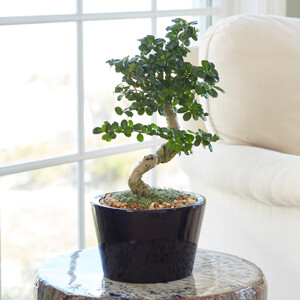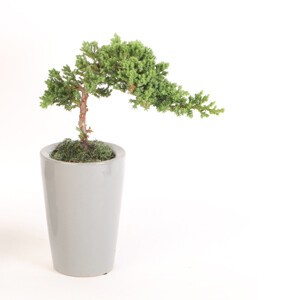Treat your bonsai right and it will reward you with beauty and inspiration for years. These sculptural little trees are long lived with proper care. By Karen Weir-Jimerson
Congratulations on being a bonsai owner!
Few plants are as stylish and sophisticated as bonsai. These tiny trees are part of a centuries-old Asian tradition of training trees into beautiful forms that exhibit symmetry and balance. Although traditional Japanese bonsai live outdoors, you can enjoy these little trees indoors—in your office, your kitchen, your bedroom, or bathroom.
A Brief History
Bonsai is not a type of plant; it’s a way of modifying a plant’s growth. The Japanese term “bonsai” explains it best: “bon” means a low pot and “sai” refers to plants. So bonsai are simply plants growing in a low pot. Growing and sculpting your own bonsai can take years. But readymade versions allow you to enjoy the beauty of bonsai right away.
Here are some basic steps to keeping your bonsai happy and in top form so it can fill your life and home with zen-like calm and beauty.

Place in the Right Light
Most trees and shrubs grown as bonsai prefer a bright spot indoors. Tropical species make for the best bonsai houseplants.
Water When Dry
Consistency is key to watering. Bonsai enjoy moist (not wet) soil. And they don’t like the up and down roller coaster of becoming too dry, then too wet. Use the “touch test” to see how dry the soil of your plant is: Scratch up the top inch of the soil—if it is dry, it’s time to water. If the soil of your bonsai is covered with pebbles or a moss mat, dig your finger underneath the mulch to determine its dryness. Don’t overwater bonsai; too much water will make the roots drown and die.

Feed Occasionally
Fertilize once or twice during the spring and summer months with a general-purpose indoor plant food.
Prune for Good Looks
Bonsai requires occasional pruning to keep its beautiful shape, maintain health, and discourage it from outgrowing its container. Spring, after new growth emerges, is the best time to trim your bonsai. Unlike most plants, you prune bonsai in two ways—by clipping and shaping their tops (leaves and branches) and clipping and removing some roots. Here is how to trim your bonsai:
Prune Leaves and Branches
Clip excess growth to keep the shape of the plant. Remove leaves or stems that detract from the balanced look of the plant. Remove dried or yellow leaves.
Trim Roots
Because bonsai are planted in small containers, pruning the roots may be necessary as the plant matures. To do this, remove the plant from its pot and trim larger roots. Make sure to keep a large number of smaller roots with lateral and hair roots. This will help keep the plant from becoming root bound.
Repotting
You can repot bonsai in larger pots, if desired. Use a pot about 3 inches in diameter larger than the previous container.